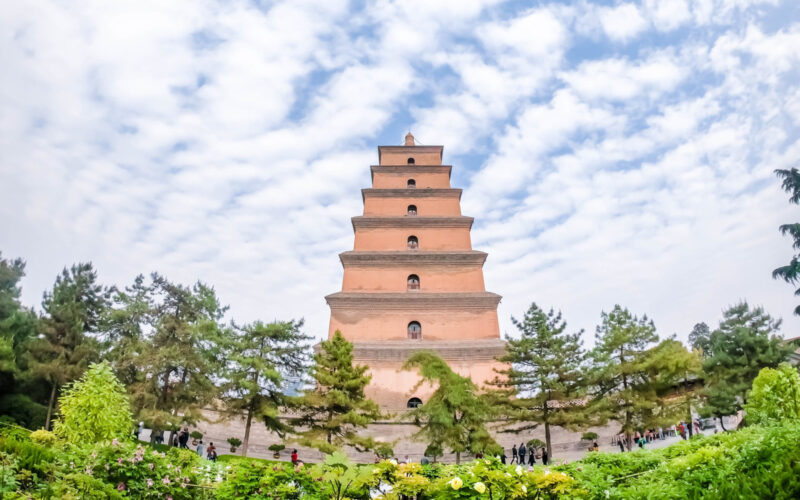Ever wondered what it feels like to walk through 3,000 years of Chinese history in a single city?
Xi’an isn’t just another tourist destination—it’s a living museum where ancient emperors once ruled, where the Silk Road began, and where you can literally touch stones that have witnessed the rise and fall of dynasties.
Whether you’re planning your first visit or returning to explore deeper, this guide will help you navigate the most captivating tourist attractions in Xi’an while uncovering stories that most visitors never hear.
From underground armies of clay soldiers to towering pagodas that have survived earthquakes and wars, Xi’an offers experiences that’ll leave you questioning everything you thought you knew about ancient China.
Let’s dive into the attractions that make this city one of the world’s most fascinating historical destinations.
The Terracotta Army: Face-to-Face with Ancient Warriors
Standing before thousands of life-sized clay soldiers, each with unique facial features and expressions, creates an almost surreal moment. The Terracotta Army isn’t just about impressive numbers—it’s about the incredible attention to detail that reveals how seriously Emperor Qin Shi Huang took his afterlife preparations.
You’ll find three main excavation pits, but Pit 1 steals the show with its organized formation of over 6,000 warriors. What many visitors don’t realize is that each figure originally held real weapons, and the bronze swords discovered here were still sharp after 2,000 years underground. The craftsmanship becomes even more impressive when you learn that different workshops created different body parts, then assembled them like an ancient production line.
Pro tip: Visit early morning or late afternoon to avoid the heaviest crowds, and don’t miss the museum’s film presentation that explains the discovery process. The story of the farmer who accidentally uncovered this archaeological treasure while digging a well adds a human element to this ancient wonder.
Xi’an City Wall: Walking Through Medieval Engineering
Few experiences compare to cycling or walking along Xi’an’s 14-kilometer city wall as the sun sets over the ancient capital. This isn’t just a wall—it’s the world’s most complete surviving ancient city defense system, built during the Ming Dynasty but standing on foundations that date back over 600 years.
The wall’s impressive statistics tell part of the story: 12 meters high, 18 meters wide at the base, and fortified with 98 ramparts. But the real magic happens during your walk. You’ll pass through four main gates, each with its own unique character and history. The South Gate (Yongning Gate) serves as the main entrance, while the views from the corners reveal how the wall perfectly frames the modern city beyond.
Renting a bicycle here transforms the experience entirely. The 90-minute ride gives you time to appreciate the wall’s engineering while enjoying perspectives of Xi’an that few tourists see. Evening visits offer the best lighting for photos, plus you’ll avoid the midday heat that can make walking uncomfortable.
Bell Tower of Xi’an: The Heart of Ancient Timekeeping
Rising 36 meters above the city center, the Bell Tower represents more than architectural beauty—it was Xi’an’s original GPS system. Built in 1384, this wooden structure (held together without a single nail) served as the city’s geographical and social center, where time announcements guided daily life.
The tower’s design showcases traditional Chinese architecture at its finest. Three layers of eaves create elegant proportions, while the interior houses a collection of ancient bells and offers exhibitions about Xi’an’s history. Climbing to the top rewards you with 360-degree views of the city, including perfect sightlines to the Drum Tower just 200 meters away.
What makes this historical site in Xi’an particularly special is its evening illumination. The golden lights transform the tower into a beacon that connects ancient traditions with modern city life. The surrounding plaza becomes a gathering place where locals practice tai chi and play traditional music, creating an authentic cultural experience.
Drum Tower of Xi’an: The Perfect Companion
While the Bell Tower announced dawn, the Drum Tower marked dusk—together they created ancient Xi’an’s rhythm. This slightly smaller but equally impressive structure houses some of China’s largest and most ornate drums, including a massive drum that required 24 cowhides to create.
The tower’s interior museum explains the intricate timekeeping system that governed ancient Chinese cities. Interactive displays let you understand how drum beats communicated everything from time announcements to emergency warnings. The acoustics here are remarkable—during daily drum performances, the sound carries across the surrounding neighborhood just as it did centuries ago.
Between the two towers, you’ll find a pedestrian area filled with shops, cafes, and street food vendors. This connection point offers one of Xi’an’s most photographed views, especially when both towers are illuminated simultaneously after dark.
Giant Wild Goose Pagoda: Buddhist Heritage and Architectural Marvel
The Giant Wild Goose Pagoda stands as Xi’an’s most recognizable landmark, but its significance extends far beyond its distinctive silhouette. Built in 652 AD to house Buddhist scriptures brought from India, this seven-story pagoda represents the cultural exchange that made Xi’an a cosmopolitan center along the Silk Road.
What sets this pagoda apart is its survival story. Despite multiple earthquakes, wars, and renovations, the structure maintains its Tang Dynasty essence. The climb to the top involves 246 steps, but each level offers increasingly spectacular views of Xi’an’s sprawling urban landscape mixed with ancient architecture.
The surrounding Da Ci’en Temple adds context to your visit. Originally covering 340 acres, the temple complex showcases how Buddhism integrated with Chinese culture. The modern addition of musical fountain shows in the adjacent square creates an interesting juxtaposition between ancient spirituality and contemporary entertainment.
Small Wild Goose Pagoda: The Quieter Sister
Often overshadowed by its famous neighbor, the Small Wild Goose Pagoda offers a more intimate experience with Tang Dynasty architecture. This 13-story pagoda, built in 707 AD, originally stood 45 meters tall but lost its top two stories during a 1556 earthquake—creating its current distinctive profile.
The pagoda’s survival story includes a fascinating chapter about natural engineering. The flexible foundation design allowed it to withstand numerous earthquakes by swaying rather than breaking. Inside, you’ll find exhibitions about the Silk Road and ancient Xi’an, with artifacts that provide context for the city’s international connections.
The Xi’an Museum grounds surrounding the pagoda create a peaceful environment perfect for understanding the site’s historical significance. The gardens here offer some of the best photo opportunities in the city, with traditional Chinese landscaping that frames the pagoda beautifully.
Muslim Quarter: A Feast for All Senses
Xi’an’s Muslim Quarter pulses with energy that’s been building for over 1,000 years. This isn’t just a tourist attraction—it’s a living neighborhood where Hui Muslim families have maintained their culture and cuisine through decades of change. The narrow streets hide culinary treasures and traditional crafts that you won’t find anywhere else in China.
The quarter’s heart beats strongest along Beiyuanmen Street, where the aroma of hand-pulled noodles, lamb kebabs, and persimmon cakes creates an intoxicating atmosphere. Local vendors have perfected recipes passed down through generations, creating flavors that reflect Xi’an’s position as a cultural crossroads.
Beyond food, the quarter showcases traditional crafts like calligraphy, jade carving, and silk weaving. Many workshops welcome visitors to observe artisans at work, providing insights into techniques that have remained unchanged for centuries. The area’s architecture blends Chinese and Islamic influences, creating a unique aesthetic that reflects Xi’an’s multicultural heritage.
Great Mosque of Xi’an: Islamic Architecture with Chinese Characteristics
Hidden within the Muslim Quarter, the Great Mosque of Xi’an represents one of China’s most important Islamic sites. Built in 742 AD during the Tang Dynasty, this mosque demonstrates how Islamic architecture adapted to Chinese building traditions while maintaining its spiritual function.
The mosque’s design follows traditional Chinese courtyard principles while incorporating Islamic elements. Four courtyards lead progressively toward the prayer hall, creating a journey that symbolizes spiritual preparation. The architecture uses Chinese-style roofs and decorations, but Arabic calligraphy and geometric patterns maintain the Islamic identity.
What makes this mosque particularly significant is its active role in the community. This isn’t just a historical site—it’s a functioning place of worship where you can observe how Islamic traditions have evolved within Chinese culture. The peaceful courtyards provide a contemplative space that contrasts beautifully with the bustling quarter outside.
Shaanxi History Museum: China’s Treasure Vault
The Shaanxi History Museum houses one of China’s most comprehensive collections of ancient artifacts, earning its nickname as “China’s Treasure Vault.” With over 370,000 items spanning from prehistoric times to the Qing Dynasty, this museum provides context for everything you’ll see throughout Xi’an.
The Tang Dynasty collection stands out as particularly impressive. Gold and silver artifacts, silk textiles, and ceramic pieces reveal the sophistication of ancient Chinese craftsmanship. The museum’s centerpiece—a set of gilded bronze horses—demonstrates the artistic achievements that made Tang Dynasty Xi’an famous throughout the ancient world.
Interactive exhibits help visitors understand how archaeological discoveries have shaped our knowledge of Chinese history. The museum’s English explanations are particularly good, making it an excellent starting point for understanding the historical sites in Xi’an you’ll visit throughout your stay.
Huaqing Palace: Hot Springs and Historical Drama
Nestled against the slopes of Mount Li, Huaqing Palace combines natural hot springs with over 3,000 years of history. This isn’t just about relaxation—it’s where emperors came to escape court pressures and where one of China’s most famous love stories unfolded between Emperor Xuanzong and his beloved concubine Yang Guifei.
The palace complex showcases different architectural styles from various dynasties, each adding layers to the site’s historical significance. The Tang Dynasty sections are particularly well-preserved, with buildings that demonstrate the architectural sophistication of ancient China’s golden age.
The hot springs themselves maintain their appeal after millennia. The mineral-rich waters that attracted emperors still flow at a constant temperature, and modern facilities allow visitors to experience the same therapeutic benefits that made this location famous. Evening visits offer the best experience, with illuminated buildings reflecting in the spring pools.
Mount Hua (Huashan): Adventure Beyond the City
Mount Hua challenges visitors with what many consider China’s most dangerous hiking trail, but the rewards justify the effort. This sacred Taoist mountain offers breathtaking views, ancient temples, and an adventure that transforms your understanding of Chinese spirituality and natural beauty.
The mountain’s five peaks each offer different experiences. The East Peak provides the best sunrise views, while the South Peak claims the title of highest point in the range. The famous plank walk—a narrow wooden path bolted to the cliff face—tests nerves while offering unparalleled photo opportunities.
What many visitors don’t expect is the spiritual atmosphere that permeates the mountain. Taoist temples dot the climbing routes, and you’ll encounter monks and pilgrims who’ve made this journey for religious reasons. The combination of physical challenge and spiritual significance creates an experience that goes far beyond typical sightseeing.
Banpo Neolithic Village Museum: Prehistoric Life Revealed
The Banpo Museum offers a fascinating glimpse into life 6,000 years ago, when Xi’an’s ancestors established one of China’s most significant prehistoric settlements. This archaeological site preserves actual dwellings, pottery kilns, and burial sites that reveal how early Chinese civilization developed.
The museum’s unique feature is its protection of the actual excavation site. You’ll walk through the original village layout, seeing houses, storage pits, and workshops exactly where archaeologists found them. The preserved remains include pottery with some of China’s earliest known writing symbols, suggesting that written communication began here earlier than previously thought.
Interactive displays help visitors understand daily life in prehistoric China. The museum explains how these early inhabitants developed agriculture, pottery-making, and social structures that influenced Chinese civilization for thousands of years. It’s a perfect complement to Xi’an’s more famous historical sites.
Xi’an Museum: Modern Presentation of Ancient History
The Xi’an Museum combines contemporary museum design with ancient artifacts to create an engaging exploration of the city’s development. Located near the Small Wild Goose Pagoda, this museum uses modern technology to bring ancient history to life.
The museum’s strength lies in its comprehensive coverage of Xi’an’s role as China’s ancient capital. Exhibits trace the city’s development from prehistoric times through multiple dynasties, showing how political, cultural, and economic changes shaped the city’s character. The Tang Dynasty section is particularly impressive, with artifacts that demonstrate why this period is considered China’s golden age.
Modern presentation techniques, including virtual reality experiences and interactive displays, make complex historical concepts accessible to visitors. The museum’s English signage and audio guides ensure that international visitors can fully appreciate the significance of the exhibits.
Daming Palace National Heritage Park: Imperial Grandeur Reconstructed
The Daming Palace National Heritage Park recreates the grandeur of the Tang Dynasty’s most important imperial complex. This massive archaeological site covers 3.2 square kilometers and includes both excavated ruins and carefully reconstructed buildings that demonstrate the scale of ancient Chinese imperial architecture.
The park’s centerpiece is the reconstructed Hanyuan Hall, where emperors held court and received foreign dignitaries. The building’s massive size—69 meters wide and 41 meters deep—gives visitors a sense of the power and wealth that characterized the Tang Dynasty. The surrounding gardens and courtyards follow traditional Chinese design principles while incorporating archaeological discoveries.
Modern facilities throughout the park help visitors understand what they’re seeing. Interactive exhibits explain the daily life of imperial court, while marked trails guide you through the most significant archaeological discoveries. The park’s size means you’ll need several hours to explore properly, but the experience provides unparalleled insight into imperial Chinese life.
Tang Paradise: Ancient Culture in Modern Presentation
Tang Paradise recreates the atmosphere of Tang Dynasty Xi’an through meticulously designed gardens, architecture, and cultural performances. This modern theme park focuses on cultural education rather than thrill rides, offering visitors a chance to experience the artistic and social achievements of ancient China’s golden age.
The park’s gardens follow Tang Dynasty landscape design principles, with pavilions, bridges, and water features that create the aesthetic environment of ancient Chinese nobility. Regular performances include traditional music, dance, and poetry readings that bring Tang Dynasty culture to life.
Evening visits offer the most spectacular experience. The park’s lighting system transforms the gardens into a magical environment, while the nightly multimedia show combines water, lights, and music to tell the story of Tang Dynasty Xi’an. The production values rival anything you’ll find in modern entertainment venues.
Qujiang Pool Park: Natural Beauty with Historical Depth
Qujiang Pool Park preserves an area that has been Xi’an’s premier recreational space for over 2,000 years. Ancient emperors and poets came here to enjoy the natural beauty and find inspiration, creating a tradition that continues today.
The park’s design balances historical preservation with modern recreational needs. Ancient pavilions and bridges dot the landscape, while walking paths and gardens provide peaceful spaces for reflection. The park’s connection to famous Tang Dynasty poets adds literary significance to the natural beauty.
Modern amenities include boat rentals, tea houses, and cultural exhibitions that help visitors understand the park’s historical importance. The combination of natural beauty and cultural significance makes this an ideal place to experience how ancient Chinese aristocracy enjoyed leisure time.
Xingqing Palace Park: Imperial Gardens Transformed
Xingqing Palace Park occupies the site of a Tang Dynasty imperial residence, transforming former palace grounds into a public space that maintains historical character while serving modern recreational needs. The park’s design incorporates archaeological discoveries with contemporary landscaping to create a unique urban oasis.
The park’s historical significance centers on its role as Emperor Xuanzong’s preferred residence. Reconstructed buildings and gardens provide insight into how Tang Dynasty emperors lived when they wanted to escape the formality of the main palace complex. The park’s lake and pavilions create scenic views that have inspired artists for centuries.
Modern facilities include exercise areas, children’s playgrounds, and cultural performance spaces that make the park popular with local residents. This integration of historical preservation with community needs demonstrates how Xi’an successfully balances heritage protection with urban development.
Forest of Stone Steles Museum: Ancient Writing Preserved
The Forest of Stone Steles Museum houses the world’s largest collection of ancient Chinese stone inscriptions, preserving over 3,000 pieces that span more than 2,000 years of Chinese writing and art. This unique museum offers insight into how Chinese culture developed through written communication.
The museum’s collection includes everything from government decrees to poetry, from historical records to artistic expressions. The Tang Dynasty sections are particularly impressive, with stone tablets that preserve the works of famous poets and philosophers. The craftsmanship of these inscriptions demonstrates how writing itself became an art form in ancient China.
What makes this museum special is its role in preserving Chinese cultural memory. Many of the inscriptions found here are the only surviving copies of important historical documents. The museum’s scholars continue to study these stones, occasionally discovering new information that changes our understanding of Chinese history.
Lishan National Forest Park: Natural Beauty Near Ancient Sites
Lishan National Forest Park offers a natural escape that complements Xi’an’s historical attractions. The park’s forested mountains provide hiking opportunities while preserving sites connected to some of China’s most important historical events.
The park’s trails lead to temples, pavilions, and scenic overlooks that have attracted visitors for centuries. The combination of natural beauty and historical significance creates an experience that balances outdoor recreation with cultural exploration. The park’s elevation provides cooler temperatures during summer months, making it a popular escape from the city heat.
Wildlife viewing opportunities include various bird species and small mammals that inhabit the forest. The park’s conservation efforts protect both natural ecosystems and cultural sites, demonstrating how environmental and historical preservation can work together.
Xi’an Beilin Museum: Alternative Name for Stone Steles
The Xi’an Beilin Museum represents another name for the Forest of Stone Steles Museum, reflecting the facility’s dual identity in Chinese and English translations. This naming variation sometimes confuses visitors, but both refer to the same remarkable collection of ancient stone inscriptions.
The museum’s organization follows traditional Chinese scholarly principles, with steles arranged by dynasty and subject matter. This systematic approach helps visitors understand how Chinese writing, philosophy, and art evolved over centuries. The museum’s research library contains scholarly works that provide context for the inscriptions.
Guided tours offer the best way to understand the significance of specific pieces. The museum’s experts can explain the historical context of important inscriptions while pointing out artistic details that casual visitors might miss. The combination of historical importance and artistic beauty makes this museum essential for understanding Chinese culture.
Datang Everbright City: Modern Entertainment with Ancient Themes
Datang Everbright City creates a vibrant entertainment district that celebrates Tang Dynasty culture through modern attractions. This pedestrian area combines shopping, dining, and cultural performances in an environment that evokes the cosmopolitan atmosphere of ancient Xi’an.
The district’s architecture follows Tang Dynasty design principles while incorporating modern amenities. Restaurants serve traditional Xi’an cuisine alongside contemporary dishes, while shops offer everything from traditional crafts to modern souvenirs. The area’s layout encourages walking and social interaction, recreating the marketplace atmosphere of ancient Chinese cities.
Evening entertainment includes traditional music performances, dance shows, and festivals that celebrate various aspects of Tang Dynasty culture. The district’s lighting creates a magical atmosphere that transforms the area into Xi’an’s premier nightlife destination while maintaining its cultural focus.
Han Yang Ling Mausoleum: Underground Imperial Treasures
The Han Yang Ling Mausoleum offers a unique museum experience built directly over an active archaeological site. This underground museum preserves the tomb of Emperor Jing and his empress while allowing visitors to observe ongoing archaeological work.
The mausoleum’s design creates an immersive experience that makes visitors feel like they’re exploring an actual tomb. Glass floors provide views of excavated burial chambers while preserving the archaeological integrity of the site. The museum’s artifacts include miniature soldiers, animals, and servants that accompanied the emperor into the afterlife.
What distinguishes this site from other imperial tombs is its focus on the archaeological process. Visitors can observe how archaeologists work while learning about the techniques used to preserve and study ancient artifacts. The museum’s educational programs explain how archaeological discoveries contribute to our understanding of ancient Chinese civilization.
Tang West Market Museum: Silk Road Commerce Revealed
The Tang West Market Museum occupies the site of the ancient Silk Road’s most important trading center, preserving the foundations of what was once the world’s largest marketplace. This museum combines archaeological preservation with educational exhibits about international trade in ancient China.
The museum’s unique feature is its construction over the actual excavated marketplace. Visitors walk through the original streets and shops while learning about the merchants, goods, and cultural exchanges that made ancient Xi’an a cosmopolitan center. The preserved foundations show how the marketplace was organized and operated.
Interactive exhibits explain how Silk Road trade brought goods, ideas, and people from across Asia to Xi’an. The museum’s collection includes artifacts from various cultures, demonstrating the international character of ancient Chinese commerce. The educational programs help visitors understand how trade relationships shaped both Chinese and world history.
Mount Zhongnan (Zhongnan Shan): Sacred Mountain Retreat
Mount Zhongnan serves as both a natural sanctuary and a spiritual retreat that has attracted hermits, monks, and philosophers for over 2,000 years. This sacred mountain offers hiking opportunities while preserving temples and meditation sites that demonstrate Chinese spiritual traditions.
The mountain’s trails connect various temples and hermitages, creating a pilgrimage route that spiritual seekers have followed for centuries. The natural beauty of the forested slopes provides a contemplative environment that explains why this location has been associated with spiritual practice for so long.
Modern facilities include visitor centers and marked trails that make the mountain accessible to casual hikers while preserving its spiritual atmosphere. The combination of natural beauty and religious significance creates an experience that balances outdoor recreation with cultural exploration.
Louguantai Temple: Taoist Philosophy’s Birthplace
Louguantai Temple claims significance as the legendary birthplace of Taoist philosophy, where Laozi supposedly wrote the Tao Te Ching. This temple complex preserves buildings and landscapes associated with the development of one of China’s most important philosophical traditions.
The temple’s architecture follows traditional Taoist principles, with buildings that harmonize with the natural environment. The complex includes meditation halls, libraries, and gardens that create spaces for contemplation and study. The temple’s connection to Laozi adds philosophical significance to the architectural beauty.
Modern restoration efforts have preserved the temple’s historical character while making it accessible to contemporary visitors. The temple’s educational programs explain Taoist philosophy while providing opportunities for visitors to experience traditional Chinese spiritual practices. The peaceful environment offers a perfect conclusion to any exploration of Xi’an’s cultural attractions.
Planning Your Xi’an Adventure
With so many incredible places to visit in Xi’an, planning becomes crucial for maximizing your experience. Most visitors need at least 4-5 days to see the major attractions properly, though you could easily spend two weeks exploring everything the city offers.
Start with the must-sees: the Terracotta Army, City Wall, and Bell and Drum Towers provide an excellent introduction to Xi’an’s historical significance. Then branch out based on your interests—history buffs will love the various museums, while adventure seekers should prioritize Mount Hua and other outdoor attractions.
Xi’an tourism peaks during spring (April-May) and autumn (September-October) when weather conditions are ideal for sightseeing. Summer can be hot and crowded, while winter offers fewer crowds but colder temperatures that might limit outdoor activities.
Transportation within Xi’an is excellent, with metro lines connecting most major attractions. Many sites are within walking distance of each other, particularly in the city center. Consider purchasing a tourist pass that includes multiple attractions plus public transportation—it often provides significant savings plus the convenience of skipping ticket lines.
Your journey through Xi’an’s attractions will reveal layers of history that few cities can match. From underground armies to towering pagodas, from ancient marketplaces to sacred mountains, each site adds another chapter to your understanding of Chinese civilization. The city’s ability to preserve its ancient character while embracing modern development creates an experience that satisfies both historical curiosity and contemporary comfort.
Whether you’re drawn by the famous landmarks in Xi’an or intrigued by lesser-known cultural sites, this ancient capital promises discoveries that will enrich your understanding of Chinese history and culture. Take time to savor the experiences—after all, you’re walking through stories that have been unfolding for over three millennia.








